The article will tell you about the unique healing properties of horse chestnut and how it can be used.
Contents of
- What is a horse chestnut?
- Chestnut horse - flowers, fruits, seed rind: medicinal properties, contraindications for women and men
- Vodka tincture: a recipe at home
- Vodka tincture from flowers: a recipe at home
- Chestnut tincture tincture: recipeat home
- Tincture, horse chestnut extract - instructions for use
- Horse chestnut drops: application
- Candles made of horse chestnut: application from hemorrhoids, constipation
- Horse chestnut ointment: application
- Chestnut tea: application of
- Decoction, horse chestnut tea: application of
- Application of horse chestnut tincture for blood thinning with varicose, thrombophlebitis, sprouts on legs
- Horse chestnut and troxerutin gel-balm cosmetic: prescription for use
- Application of horse chestnut tincture for the treatment of joints
- Application of tincture of horse chestnut against pressure
- Application of horse chestnut tincture against prostatitis, prostate adenoma
- Treatment of common cold horse chestnut: how to carry out?
- How to use tincture of horse chestnut flowers from mastopathy
- How to rub horse chestnut tincture with leg swelling?
- Horse chestnut flowers application for oncology and cancer prevention
- Valerian, horse chestnut, motherwort, hawthorn, peony: recipe for use
- Banyaga forte and horse chestnut: instruction manual
- Alcoholic tincture of horse chestnut - allergic reactions: symptoms
- Video: "Horsechestnut from varicose veins »
What is a horse chestnut?
This plant, like chestnut, is known to everyone, but far from everyone knows that in the original it should be called "horse chestnut".In addition, that this tree is very beautiful, pleasing with lush vegetation and beautiful color, it is the basis for the preparation of many recipes of health in folk medicine.
With one broom of flowers ripens about 5 fruits. Fruits are green capsules covered with spines. Inside the box is the seed of the nut. Each fruit has a rich brown color, the seed reaches a size of up to 4 cm in diameter. Chestnuts ripen in late summer, early autumn.
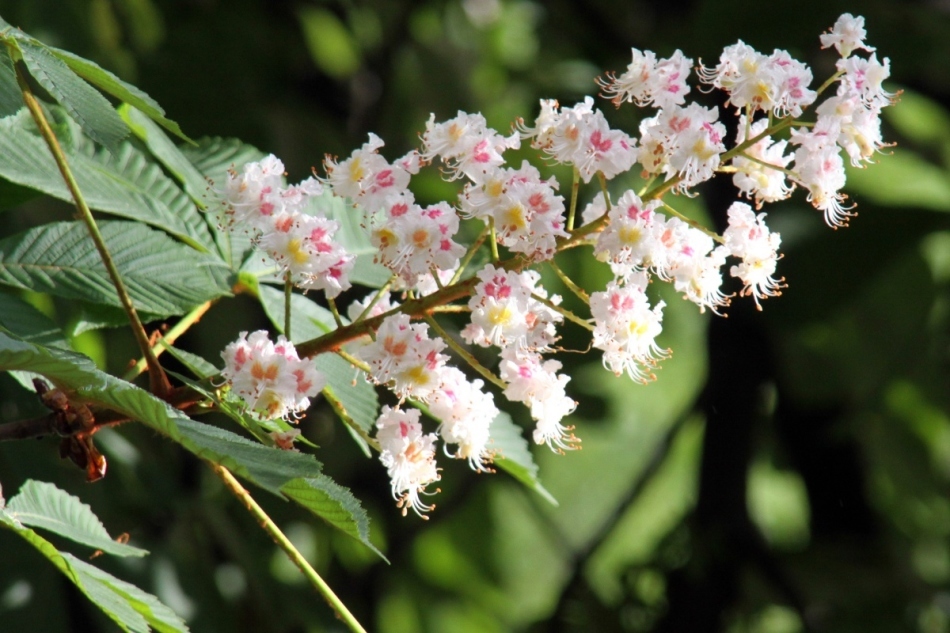 Blossom of horse chestnut
Blossom of horse chestnut 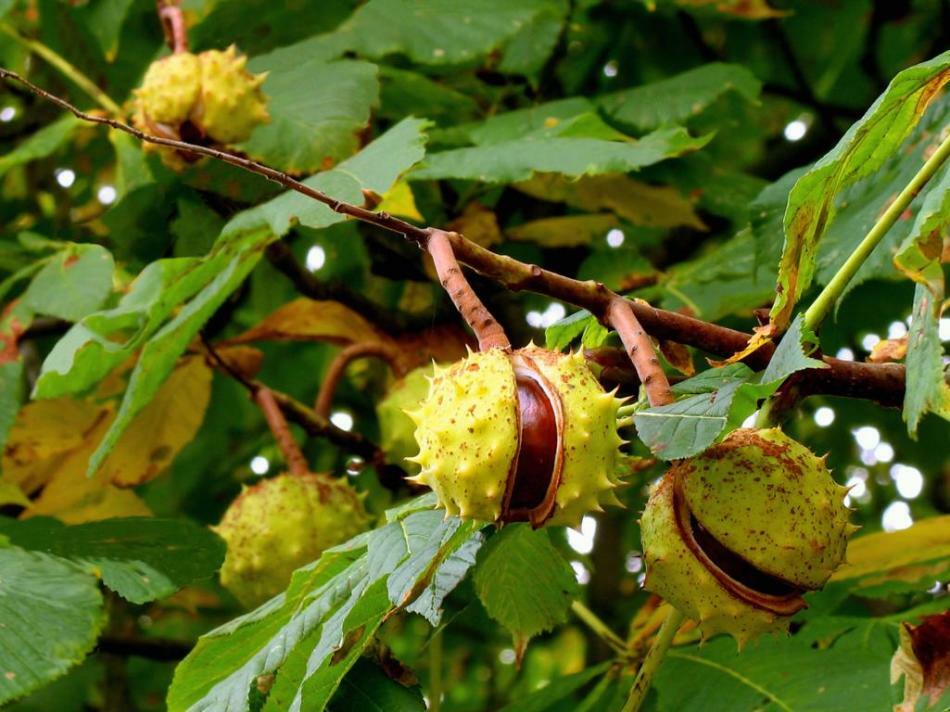 Horse chestnut fruits
Horse chestnut fruits Chestnut horse - flowers, fruits, seed rind: medicinal properties, contraindications for women and men
Not only flowers and fruits of the plant possess medicinal properties, you can also use bark and tree seeds. The effectiveness of medicines prepared from chestnut depends on how well the harvest is collected and prepared.
How to collect:
- Fruits - are collected in August and September. They are thoroughly cleaned from the pericarp( peel).In the open air, the fruit should be dried for 3-4 weeks or with a special drying( you can also keep them in the oven for several hours at 40-50 degrees).
- Bark - is cut only in spring( April-May), when it accumulates the maximum amount of nutrients. Cut bark should be from trees that are not "younger" than 3 years of age, but not older than 5. The collected bark should be completely dried.
- Leaves - can be collected between May and September, but only until the leaves have begun to turn yellow. Collect leaves from young trees that do not exceed a height of 3 meters.
- Flowers - gather in April and May in a period of lush flowering.
Horse chestnut has a rich chemical composition that is able to bring a person a great benefit:
| Ingredient name | Benefits for humans |
| Eszin | Improves the functioning of blood vessels and capillaries, helps the thyroid to release a number of necessary hormones, regulates the water-salt and lipid balance of the body. |
| Fatty oils | Anti-inflammatory and antiseptic. |
| Tanning agents | Treatment of burns, digestive tract disorders, disposal of toxins, healing of wounds and ulcers. |
| Globulin | Regulates hormones |
| starch Splitting into glucose, gives the body an energy source. | |
| Lecithin | Participates in all metabolic processes of the body. |
| Vitamin C With | Has an antiseptic effect on the body, strengthens immunity, fights against viruses and microbes. |
| Vitamin A | Strengthens the immune system, helps to develop cell membranes and all internal organs, improves the protective properties of the skin. |
| Vitamin K | Improves skin coagulation and helps the kidneys. |
| Vitamin B | It participates in all metabolic processes of the body, helps to work harmoniously all body systems, favorably affects the skin, hair and nails, helps the thyroid to produce all the necessary hormones. |
| Organic acids | Withdraw from the body toxic substances, improve the functioning of the cardiovascular system and normalize the metabolism. |
| Thiamin | Improves brain function, helps the digestive system, participates in the blood-shed function. |
| Carotene | Strengthen the protective properties of the body, have a healing and rejuvenating effect on the body. |
| Coumarin | Provides prophylaxis of neoplastic tumors, helps in healing wounds. |
| Flavonoids | Improve the performance of the cardiovascular system and blood quality. |
| Pectines | Provide a "sanitary" effect on the body: remove toxins and toxins, help to cleanse the intestines from putrefactive bacteria, remove salts of heavy metals and radionuclides. |
| Glycosides | Normalize the work of the cardiovascular system, accelerate the healing of wounds and improve metabolism. |
| Slime | Accelerate wound healing and eliminate inflammation. |
Benefits of chestnut-based products:
- Powerful analgesic action of , both with external and internal reception.
- With the help of such tools it is possible to render a disinfecting( bactericidal) and hemostatic effect on wounds obtained by mechanical means.
- Antiseptic action of - eliminate inflammation.
- Drugs of internal use are able to render a diuretic effect of on the body. It is also possible to remove .
- Some recipes are able to render an antioxidant and rejuvenating property of the .
- Chestnut is known as the effective venonizing agent against blood clots.
- Medications will also help to provide antipyretic and sweating.
What is useful "buckeye»:
- Combats puffiness
- Eliminates
- inflammation Relieves pain from joints
- strengthens capillaries and blood vessels
- «loose" blood clotting
- is the prevention of blood clots
- Removes
- spasms normalizes acidity
- stomach Improves
- heart Improves liver function
- Improves kidney function
- Normalizes pressure
- Normalizes cholesterol level
- Improves digestive process
- Displays toxins
"Horse chestnut" lechit:
- Malaria
- Dysbacteriosis
- Bronchitis
- tuberculosis
- Diarrhea
- Hemorrhoids
- Leukemia
- arthritis and arthrosis
- Radiculitis
- Diseases associated with gall bladder
- sexual dysfunction
- Prostatitis
- gastric acidity( increased)
- Ulcers
- Gastritis
- Problems with spleen
- Uterinebleeding
- Vascular diseases
- CNS diseases
- Gout
- Anemia
- Varicose veins
- Pertussis
- Heart diseases
- Muscle inflammations
Likeuse the "horse chestnut" for treatment:
- Flowers - recipes are applied externally as scraps to relieve the inflammatory process.
- Leaves - should be used for topical medications( as an analgesic and anti-inflammatory drug).
- Fruits - are used for the preparation of external and internal use.
- Bark - is often used as a powerful anti-inflammatory and antipyretic agent.
 How to use a chestnut and what is it useful for a person?
How to use a chestnut and what is it useful for a person? Tincture on vodka from fruits: a recipe at home
Tincture from collected fresh chestnut fruits is often used to treat many inflammatory joint diseases, varicose veins on the lower limbs, as well as diseases such as hemorrhoids and prostatitis. You can easily buy chestnut tincture in a pharmacy, but you can also prepare it yourself at home on alcohol or pure vodka.
When preparing tinctures, it is important to consider the proportions so that the product is effective. The fruits of chestnut( nuts) are considered the most useful part of the plant, as the tree spends most of the nutrients on them. Before preparing the tincture, it is necessary to clean the scaffolds from their shell and skin( brown dense membrane).
How to prepare tincture on fruits:
- 10 g shredded walnut without skin put in a small glass container
- Pour the crushed chestnut 100-110 ml of vodka or alcohol
- Infuse the product in a dark place where sunlight does not penetrate
- Keep the tincture 7-10 days
- In addition,to be warm, it should also be cool
- Every day should be shaken by hand
- Only after infusion the remedy can be removed for further storage on the refrigerator shelf
Tincture on vodka from flowers: a recipe inhome conditions
Preparation of medicinal tincture on flowers is very similar to the one that is prepared with chestnut fruits. To get 100 ml. The finished product you should have:
- 100 ml.clean vodka( without flavors and flavors, choose good quality vodka or alcohol).
- 10 g. Flowers( collect when the flowers are colored with a yellow piment, not red).
Workpiece:
- Put the colors in a glass container for infusion
- Fill the colors with alcohol or vodka
- Shake well the container
- Close the container with a lid
- Remove the container into a cool, dry and dark place
- Store the product 7-10 day
- Each day the container should be shaken well
- After infusion, strain the tincture and flip the cake
- The tincture can be stored in the refrigerator for a year.
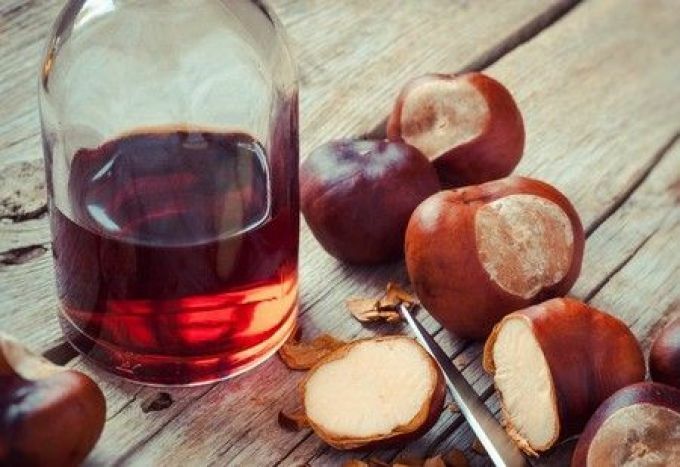 Home preparation of chestnut tincture
Home preparation of chestnut tincture Tincture on vodka from the peel of chestnuts:Fri at home
Tincture on the bark of chestnut is a powerful bactericidal, anti-inflammatory and analgesic agent of local action. Prepare the tincture on the bark of young trees, which are not more than five years old. Collecting bark should be in the period from May to August.
How to prepare:
- A glass of bark chestnuts should be washed and dried in a dry place without direct sunlight.
- After this, the crust should be crushed as much as possible by a mortar or other convenient tool.
- Bark pour into a glass jar and pour 700-800 ml.pure alcohol or vodka without any additives.
- Shake well and remove for infusion( as usual, it should be a bit cool and dark place where the sun does not penetrate).
- Insist the remedy for 10-14 days, every day by vigorously shaking the container.
- After infusion, strain the liquid and discard the remnants of the bark. Keep in the fridge.
Tincture, horse chestnut extract - instructions for use
Tincture on a chestnut( fruit, bark or flowers) is an effective remedy against many inflammatory diseases. In addition, the tincture is allowed for internal and external use to improve the functioning of the circulatory and cardiovascular system.
Chestnut tincture is applied when:
- Inflammation of joints( and other joint problems) - is used externally. It is necessary to lubricate the inflamed joint three times a day.
- Varicose veins( swelling of the veins and their enlargement) - should be lubricated with a tincture of the limb each time after the load. Also used tincture internally, daily noma - 25 drops. The course of treatment tincture internally - no more than 20-22 days.
- Prostate( inflammatory urinary tract disease in men) - it is necessary to combine the use of tincture with traditional treatment. The course of treatment is 21-22 days. Daily rate of 20-25 drops( divided into 2-3 doses, drink with water 30-40 minutes before meals).
- Rheumatism( acute and chronic) - is applied externally as rubbing on the affected back area.
- Diseases associated with poor bile flow - the is taken internally. The course of treatment is 7-9 days( until the condition improves).Daily rate - 30 drops, divided into 3 doses.
- Gout - is used exclusively externally, it is necessary to make alcoholic lotions on the affected area when an attack occurs.
- Infringements of arterial pressure - the tincture internally is used, it is desirable to drink fruit fruit of chestnuts. The course of treatment is 20-21 days, daily rate - 25 drops( you can drink immediately or divide by 2-3 admission).
- Thrombophlebitis - 30 drops of tincture( any part of chestnut) should be divided into 4 doses and drink by a course of two weeks.
- Neuralgia - tincture divide into three or four receptions and drink a day 35-40 drops. The course of treatment is 25 days.
Contraindications on the use of chestnut tincture:
- Stomach ulcer
- Constipation( chronic and acute)
- Bad blood clotting
- Kidney diseases
- Liver diseases
- Low blood pressure
- Heart diseases( severe)
- Gastritis
- Severe allergic predisposition to component
- Disrupted hormonalbackground
- Painful menstruation
- Pregnancy
- Lactation period
- Individual intolerance
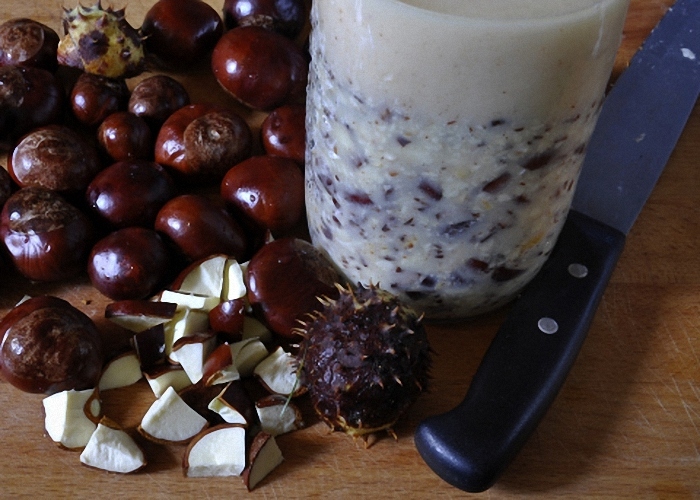 Effective treatment with tincturehorse chestnut
Effective treatment with tincturehorse chestnut Drops of horse chestnut: application of
Such a tool, like drops obtained from horse chestnut, is not very common, but still gained its popularity as an effective tool for losing weight. This drug is a concentrated agent that complexly affects the entire body, providing an internal and external property.
Than the help of drops of horse chestnut:
- Getting together with food, break down fats.
- Help to cleanse the intestines from accumulated slags and toxins, putrefactive bacteria, stagnant stools.
- Regulate the water-salt balance in the body, preventing the liquid from stagnating in soft tissues.
- Regulate lipid metabolism in the body.
- Improve appetite, but nonetheless, do not give rise to excessive feelings of hunger.
- Normalize all metabolic processes of the body, improving the general well-being of a person.
Take drops 2 or 3 times a day. Single intake rate - 1 tsp. The drug should not be taken if you have stomach ulcers, pregnancy, or you are experiencing lactation. Also, discontinue the drug if you observe a poor tolerance after taking and an allergic reaction: itching, rash on the skin, fever, nausea and vomiting.
Horse chestnut candles: application from hemorrhoids, constipation
A powerful anti-inflammatory and healing property of chestnut has been used to treat a disease such as hemorrhoids. You can buy candles from horse chestnut in the pharmacy. The action of the candles is aimed at the removal of the inflammatory process in the anus, the bactericidal property( locally eliminates pathogenic and putrefactive bacteria), heals microcracks.
In addition, the candles act very gently and do not give any unpleasant sensations. They can also be used to relieve stools with prolonged or chronic constipation. The same property is very effective in hemorrhoids, when the process of defecation occurs painfully. The daily norm of candles is 2 per day: morning and evening.
Horse chestnut ointment: application of
Horse chestnut ointment is an effective topical agent against inflammatory processes in the joints and soft tissues. Its popularity has also earned its ointment in the treatment of varicose veins. Chestnut extract allows to increase the elasticity of blood vessels, promotes resorption of cholesterol plaques, improves blood flow, relieves swelling and fatigue from the limbs affected by the disease.
Horse chestnut ointment can be rubbed into the skin, or with its use to do massage. Daily lubricate the diseased legs with ointment, paying special attention to the sites with swollen veins. Ointment applied a thin layer, rub until completely absorbed. Massage with ointment must be done correctly: movements go from bottom to up, without strong pressure.
 Horse chestnut ointment for the treatment of varicose veins
Horse chestnut ointment for the treatment of varicose veins Horse chestnut cream: application of
The horse chestnut cream is very similar in its effect to an ointment, but it is less concentrated. It can be used for daily lubrication of limbs affected by varicose veins or massage with it.
In addition, this cream has a good toning ability, it relieves fatigue and relieves them of swelling. The cream should be used to lubricate the legs, hands or joints after a load or with pain. After applying the cream, it is recommended to roll out a sore spot with a woolen shawl for a while.
Decoction, horse chestnut tea: application of
The simplest preparation that anyone can prepare from any part of the plant is a decoction or infusion on boiling water. The use of this decoction is very versatile and it is able to affect many body systems, eliminating inflammatory diseases, providing bactericidal and even analgesic effect. In addition, the broth is able to give the body the necessary complex of vitamins and normalize the pressure.
Decoction is most often done on leaves and chestnut flowers, bark and fruits are used to make alcohol tinctures. Prepare a decoction or infusion on boiling water is simple enough:
- Take 50 g. Of fresh or dried flowers( leaves)
- Pour them 250-270 ml.(about 80 degrees)
- Cover the container with a plate or cover
- Let it brew until completely cooled
- Strain and eat internally
- Divide the broth for two or three meals, eat it before meals for 30-40 minutes.
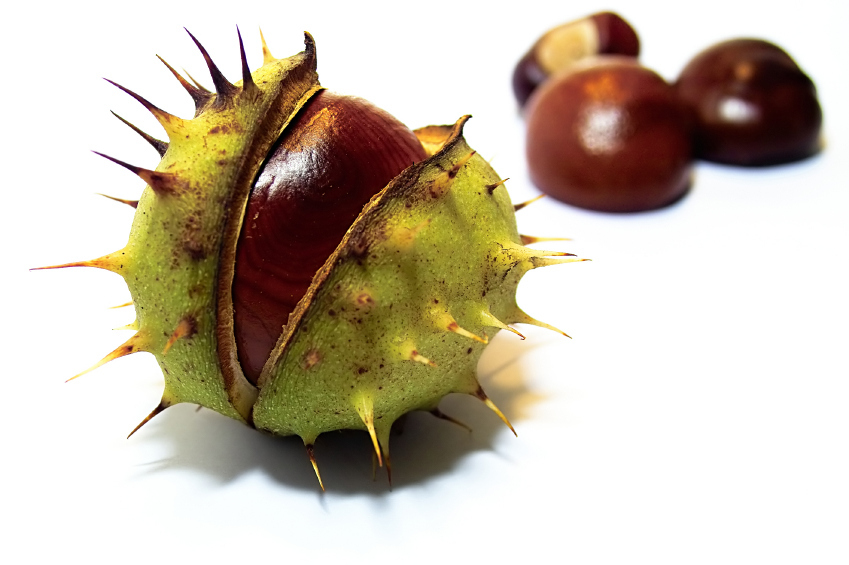 Chestnut-based preparations
Chestnut-based preparations Application of horse chestnut tincture for blood thinning with varicose, thrombophlebitis, sprouts on legs
Varicose veins are observed when a person has a number of chronic diseases, leads an unintended lifestyle or, conversely, allowsoverexertion. Not infrequently varicose suffer those who are experiencing diseases associated with frequent high blood pressure, malnutrition, obesity.
Varicose is the deposition of cholesterol plaques on the walls of blood vessels. As a result, blood flow is disrupted and a person can experience a number of unpleasant sensations: poor overall health, hypertension, headaches, depression, fatigue. Improve your condition will help regular intake of drugs based on horse chestnut and lubrication of the limbs with ointment, or cream from horse chestnut.
What helps buckeye with varicose veins:
- Increases elasticity of blood vessels
- absorbable cholesterol plaques
- Improves circulation
- blood thinning
- Eliminates puffiness
- feet Hides the leg fatigue and heaviness
- Eliminates swelling
- veins Makes veins more "lighter" and less visible on
- skinEliminates venous "asterisks" on the legs
How to use horse chestnut-based remedies:
- Daily lubricate the feet once or twice a day with a horse chestnut cream.
- Once a day or several times a week, massage the limbs with ointment of horse chestnut.
- Course in 1 month 4-5 times a year to drink chestnut broth( leaves or flowers) for 1 glass every day, dividing it into 3 meals.
Horse chestnut and troxerutin gel-balm cosmetic: recipe for application
This gel-balm in combination with horse chestnut-based products allows you to have not only a wellness but also a cosmetic effect on your limbs. Applying these two components on your feet, you:
- Improve blood circulation in the extremities
- Remove puffiness from the feet
- Eliminate fatigue( for example, when wearing high-heeled shoes).
- Eliminate the venous network and the asterisks
- Do the prevention of varicose
- Allow the legs to withstand more severe stresses
Use of horse chestnut tincture for the treatment of
joints An inflamed joint can make itself felt with sharp and growing pain. Eliminate discomfort, remove pain syndrome and provide antiseptic effect will allow tincture, prepared for alcohol from horse chestnut. Any part of the plant can be used for this purpose, but fruits without skin are more preferable.
The obtained tincture should be used place, rubbing a small amount of the drug into the diseased joint. Do this rubbing should be 2-3 times a day. After rubbing it is recommended to wrap the joint in a woolen shawl and not disturb for about 2-3 hours.
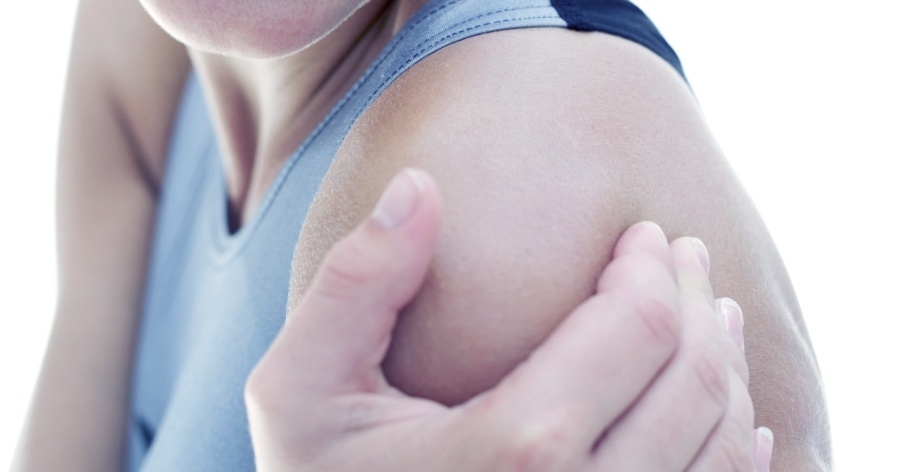 Joint treatment
Joint treatment Application of tincture of horse chestnut against pressure
The increased pressure arises from the fact that the blood of a person is too "thick".That's why the blood flow slows down, the brain and internal organs do not get enough oxygen, headaches, poor health, general malaise.
You can get rid of pressure only by diluting blood. To do this, it is recommended to drink a tincture of horse chestnut, or replace it with a decoction of flowers or fruits. The course of treatment is 20-25 days, until recovery. If one course was not effective, you should arrange a break of 20 days and repeat the course.
Use of horse chestnut tincture against prostatitis, prostate adenoma
Inflammatory disease of the prostate gland in men is very painful and unpleasant. Therefore, together with the traditional treatment should be ancillary with the help of a tincture of horse chestnut.
Drink a tincture of fruits, flowers, bark or leaves( fruits and flowers are preferable), should be in the amount of 25 drops per day. The dose should be divided into three doses. The course of treatment is 2-3 weeks before the improvement of health. The tincture is diluted with water and drunk 30 minutes before meals. A horse chestnut is treated with a cold: how to carry out?
Extract of horse chestnut or drops of horse chestnut can be used to treat sinusitis. Also effective are tampons dipped in chestnut broth and inserted for 20 minutes in the nasal sinuses. The drug will have an anti-inflammatory effect on the mucous membrane, promote the liquefaction and withdrawal of mucus, as well as kill disease-causing bacteria that caused a runny nose.
Application of tincture from horse chestnut flowers from mastopathy
Tincture of chestnut flowers can be used as a medicine in the treatment of the inflammatory process of the breast. To do this, every day should make lotions of alcohol tincture, which should be kept for 20-30 minutes. Alternatively, you can also use the tincture of the pods.
How to rub the horse chestnut tincture with leg swelling?
Puffiness of the feet often occurs in those who spend a lot of time on the move, wear uncomfortable shoes, shoes on the heel or suffers from excess weight, resulting in a heavy load on the legs. To get rid of this unpleasant sensation, every evening before bedtime, rub your feet with chestnut tincture( any part).After you put on your feet woolen socks and give your feet rest for several hours.
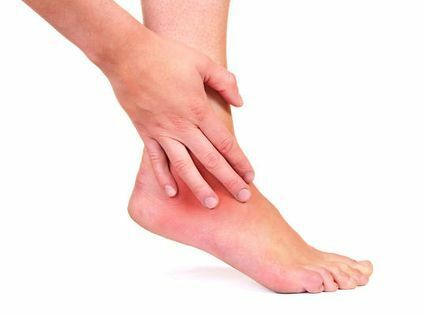 Horse chestnut treatment
Horse chestnut treatment Horse chestnut flowers application in oncology and cancer prevention
The chestnut contains a number of important microelements aimed at improving the body. In particular, decoctions and infusions of flowers( and fruits) can be used for the prevention and treatment of cancer. Chestnut extract prevents and inhibits the development of cancer cells, as well as radionuclides.
IMPORTANT: You should treat the course at 1 month 4 times a year, with 1-2 months or more interruptions. You can drink a decoction and chestnut tincture.
Valerian, horse chestnut, motherwort, hawthorn, peony: prescription for
application Valerian, chestnut, Leonurus, peony and hawthorn infusion is an effective remedy for hypertension:
- Valerian dilates blood vessels
- Chestnut makes blood more viscous
- Motherwort soothes
- Hawthorn lowers excitability
- Peonynormalizes sleep
IMPORTANT: All components should be mixed in equal proportions. The daily norm of the drug is 50 drops, which should be divided into 3-4 doses.
Banyam forte and horse chestnut: instruction for use
Banyak extract in addition to horse chestnut is a powerful venotonic and vasoconstrictor that has anti-edematous action. Apply the gel on clean skin 2 or 3 times a day.
Alcoholic tincture of horse chestnut - allergic reactions: symptoms of
Allergic symptoms for intolerance of horse chestnut extract are similar to any other allergic sensations:
- Nausea
- Vomiting
- Skin rash
- Redness and pruritus of skin
- Stomach pain
- General malaise
- Drowsiness
- Spasmsin the intestine
- Temperature rise
